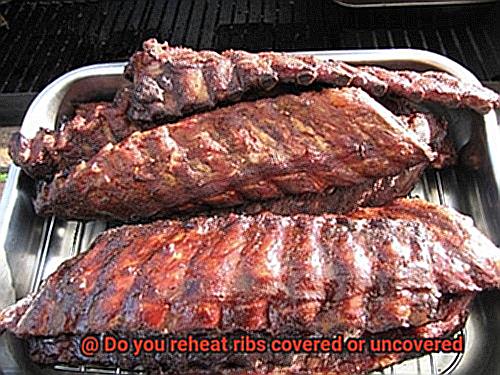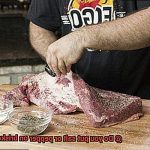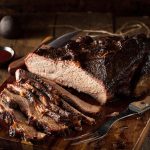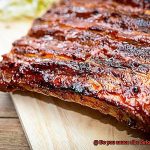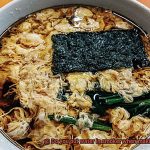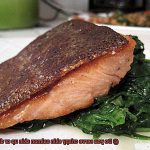If you’re a true rib fanatic like me, then you know how crucial it is to reheat them just right. But the million-dollar question remains: should you reheat ribs covered or uncovered? It may seem like a simple query, but trust me when I say that reheating ribs incorrectly can make your once mouth-watering meat less than appetizing.
As someone who has had their fair share of reheated ribs, I’ve learned that there’s no one-size-fits-all approach to this dilemma. It all boils down to personal preference and the initial cooking method used. However, one thing is for sure – how you choose to reheat your ribs can significantly impact their taste and texture.
So, whether you’re dealing with leftover BBQ from last night’s party or simply craving some good ol’ fashioned ribs on a weekday evening, this post will be your ultimate guide. We’ll explore the differences between reheating ribs covered versus uncovered and provide some nifty tips and tricks to ensure perfectly reheated ribs every time. So sit back, crack open a cold one, and join us on this lip-smacking journey as we discover the best way to reheat your beloved ribs.
Contents
What Type of Ribs Should be Covered or Uncovered?
Reheating them is the perfect solution for another delicious meal. However, the question remains: should you cover them or leave them uncovered? Well, it all depends on the type of ribs you have and the method you are using to reheat them.
Let’s start with dry-rubbed ribs. These ribs are best reheated uncovered. Why? This allows the moisture to escape, preventing the ribs from becoming soggy. You want your dry-rubbed ribs to be crispy on the outside and tender on the inside, so leaving them uncovered during reheating is crucial.
On the other hand, if you have sauced ribs, then it’s best to reheat them covered. The sauce can easily dry out and become crusty if left uncovered. By covering the ribs, you lock in the moisture, ensuring they remain tender and juicy.
It’s essential to note that the type of ribs also affects how long you should reheat them for. For instance, baby back ribs take less time to reheat than spare ribs because they are smaller and more tender.
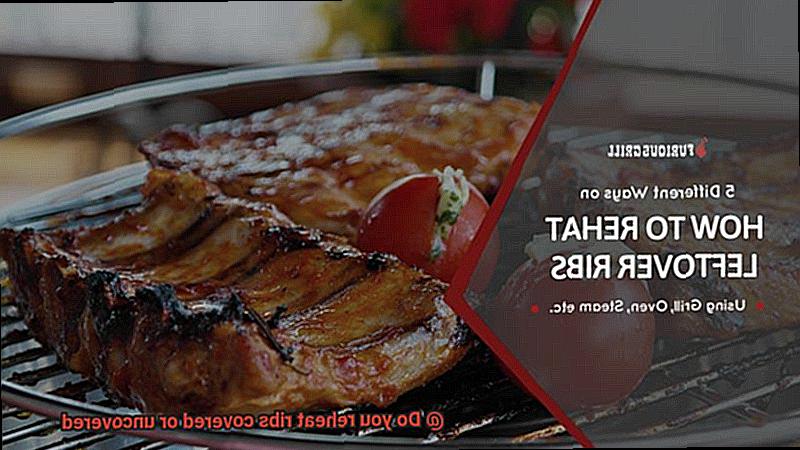
Moreover, the reheating method also plays a role in whether or not you should cover your ribs. If you’re using an oven or smoker, covering your ribs during reheating can help retain heat and moisture. However, if you’re using a grill or microwave, leaving your ribs uncovered is a better option as it helps them crisp up and retain their texture.
In conclusion, reheating your leftover ribs doesn’t have to be complicated. By following these guidelines, you can ensure that your reheated ribs are just as delicious as they were when they were first cooked. To recap:
- Dry-rubbed ribs: Reheat uncovered.
- Sauced ribs: Reheat covered.
- Baby back vs. spare ribs: Adjust reheating time accordingly.
- Reheating method: Consider whether to cover or leave uncovered.
What Method is Being Used to Reheat the Ribs?
There are several methods that can be used to achieve the juicy and tender taste you crave. As an expert on ribs, I’ve done the research and compiled the best methods for reheating your ribs.
Let’s start with the classic oven method. Preheat your oven to 250-300°F and place your ribs in a baking dish or on a baking sheet. To make sure they don’t dry out, cover them with foil before baking for 20-30 minutes or until they’re heated through. This method is perfect for those who want evenly reheated ribs without any fuss.
For those who love that smoky flavor, the grill method is a great option. Preheat your grill to medium heat and brush your ribs with barbecue sauce or a mixture of oil and spices. Place them on the grill bone side down and cover with foil or lid to trap in heat. Grill for 10-15 minutes, flipping occasionally, until heated through and charred to perfection.
If you’re short on time, the microwave method is a quick and easy way to reheat your ribs. Put the ribs in a microwave-safe dish and cover them with a damp paper towel or plastic wrap before microwaving on high for 1-2 minutes per rib or until they’re heated through. This method may not give you that crispy exterior, but it’s still a delicious option.
For those who want a more high-tech option, try the sous vide method. Vacuum seal your ribs and place them in the sous vide machine at 155°F for 45 minutes to an hour. This method ensures that your ribs are evenly reheated without overcooking the meat.
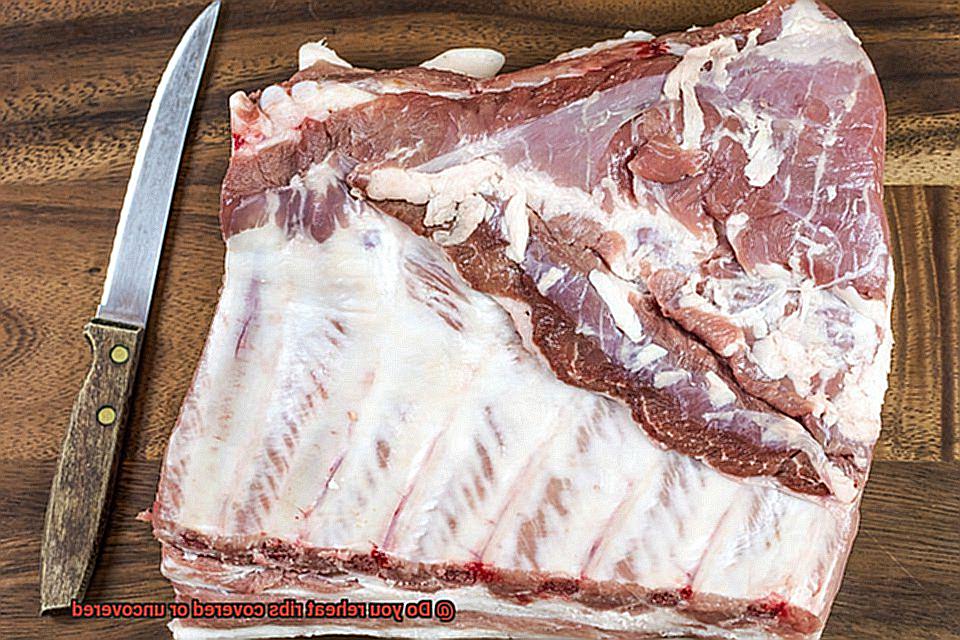
Benefits of Covering the Ribs During Reheating
As an expert in the field, I can assure you that covering your ribs during reheating is the way to go. Let’s explore the benefits in more detail.
Firstly, covering your ribs helps to retain moisture, a crucial factor in keeping them juicy and tender. Without a cover, reheating can quickly dry out your meat, leaving it tough and tasteless. But by creating a seal that traps in moisture, you’ll be left with succulent rib meat that’s sure to satisfy your cravings.
Secondly, covering your ribs distributes heat evenly throughout the meat. Without a lid, you run the risk of uneven heating, with some parts too hot and others too cold. But with a cover in place, an even layer of heat warms every inch of your ribs, ensuring they’re heated throughout. This results in a more consistent and enjoyable eating experience.
Another benefit of covering your ribs is preventing them from sticking to the pan or grill. This is especially important when reheating sauced ribs as the sauce can easily stick and ruin their appearance. By creating a protective barrier, you’ll preserve the look of your ribs and avoid wasting any tasty sauce.
Lastly, covering your ribs during reheating allows for additional flavor infusion. The closed environment created by the cover allows flavors to meld together and intensify, resulting in more flavorful and delicious ribs that are sure to impress even the pickiest eaters.
Benefits of Not Covering the Ribs During Reheating
While covering your ribs may seem like the obvious choice, there are actually some compelling reasons to leave them uncovered.
Firstly, uncovering your ribs allows for even heat distribution throughout the meat. When covered, the steam that builds up inside can create pockets of uneven heating leading to dry or overcooked meat. Uncovering your ribs ensures that heat circulates evenly, leaving you with perfectly heated meat every time.
But that’s not all. Leaving your ribs uncovered allows excess moisture to evaporate, resulting in a crispy exterior that will have you salivating. This is especially crucial if you are reheating sauced ribs as covering them can cause the sauce to become watery and dilute the flavor.
Moreover, uncovering your ribs during reheating enhances the visual appeal of the dish. The caramelized exterior and crispy texture of the ribs make for a visually stunning and appetizing meal that will impress your guests.
Tips for Perfectly Reheated Ribs Every Time
Reheating ribs can be a bit tricky, but with these tips, you can achieve perfectly reheated ribs every time. Here are five sub-sections to help guide you through the process:
Consider the Type of Ribs
Before reheating your ribs, it’s important to consider whether they are sauced or dry. If they are already sauced or have a lot of moisture, covering them during reheating may cause them to become soggy and lose their texture. On the other hand, if your ribs are dry and in need of some moisture, covering them can help retain their juiciness.
Reheat Slowly and at a Low Temperature
It’s crucial to reheat your ribs slowly and at a low temperature to prevent overcooking and drying out. This will ensure that your ribs remain tender and juicy. If you’re using an oven, set it to 250°F and cover the ribs with foil to trap in moisture. For grilling or smoking, use indirect heat and avoid high temperatures that could dry out the meat.
Use Indirect Heat
If you originally cooked your ribs low and slow in a smoker or on a grill, then you’ll want to reheat them in a similar way to preserve their tenderness and flavor. This means using indirect heat and avoiding high temperatures that could dry out the meat. For best results, use a smoker or grill with a temperature of around 225°F and let the ribs cook for about 30 minutes.
Add Liquid
To keep your reheated ribs moist, add a small amount of liquid to the pan before covering it with foil. This could be anything from water or broth to barbecue sauce or apple juice. Adding liquid can help create a steamy environment that keeps the ribs juicy and flavorful. If you’re grilling or smoking your ribs, you can also spritz them with apple cider vinegar or a mixture of water and apple juice to keep them moist.
Let Your Reheated Ribs Rest
After reheating your ribs, let them rest for a few minutes before serving. This allows the juices to redistribute throughout the meat and ensures that each bite is tender and flavorful. Cover the ribs with foil and let them rest for about 10 minutes before slicing and serving.
How to Avoid Soggy or Dry Ribs When Reheating
Reheating ribs can be a tricky task, as you want to maintain their juicy and flavorful taste. To avoid ending up with soggy or dry ribs, try these tips:
Cover or uncover? It depends on the method
When it comes to reheating ribs, the first thing to consider is the method you will use. If you’re using an oven or smoker, covering the ribs during the reheating process can help retain heat and moisture. However, if you’re using a grill or microwave, leaving your ribs uncovered may be a better option as it can help them crisp up and retain their texture.
Uncover for less moisture
If you want to avoid having soggy ribs when reheating, it’s best to reheat them uncovered. This allows the moisture to evaporate and prevents the ribs from becoming too moist. When reheating uncovered, be sure to keep a close eye on the temperature and remove the ribs from heat before they become too dry.
Cover for more moisture
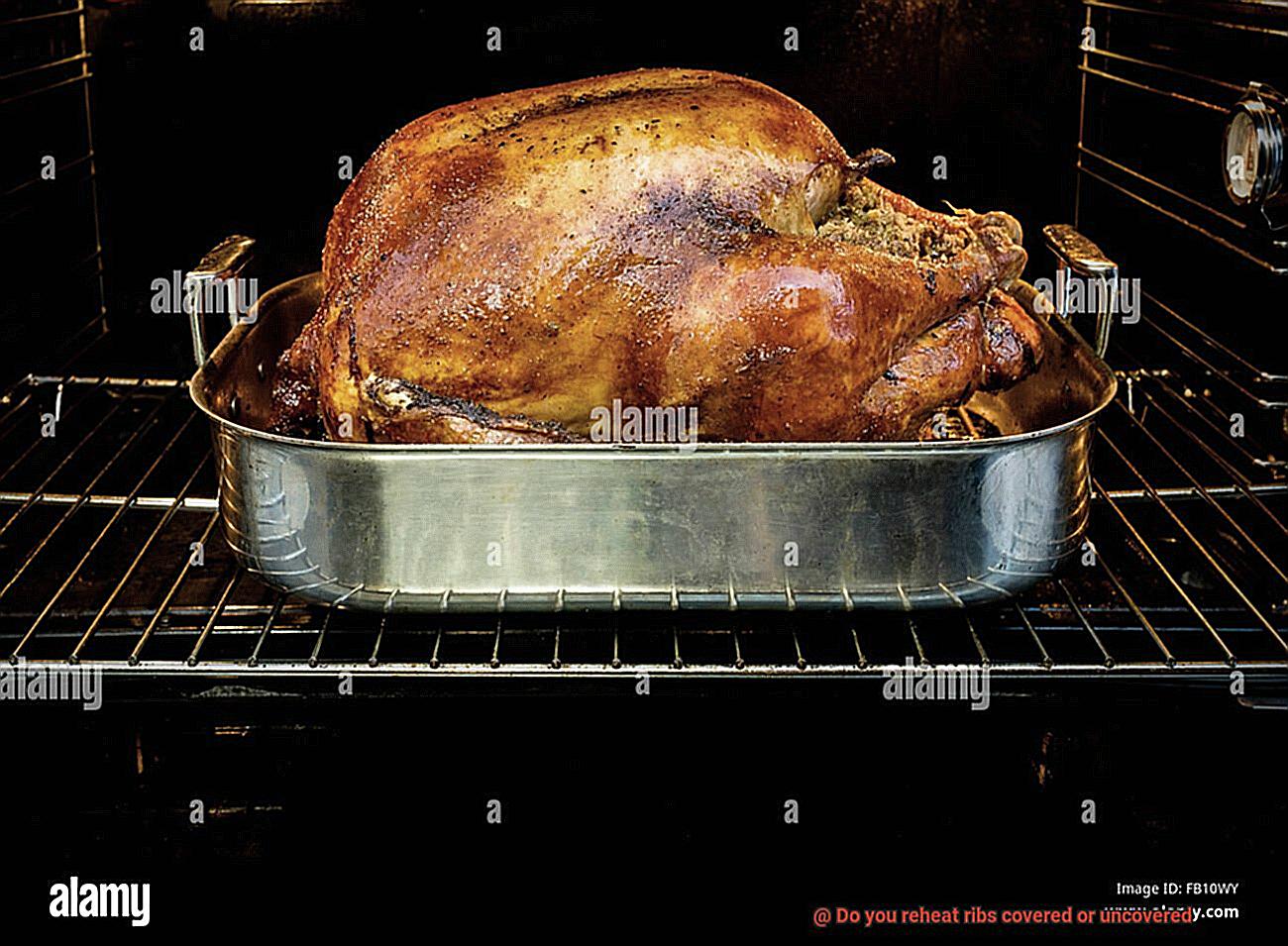
On the other hand, if you want to avoid dry ribs when reheating, covering them can help retain moisture. When covered, the steam produced by the ribs helps keep them moist and juicy. However, it’s important not to overcook the ribs when covered as this can cause them to become too soft and mushy.
Avoid foil or plastic wrap
One of the most common mistakes people make when reheating ribs is covering them with foil or plastic wrap. While this may seem like a good way to retain moisture, it can actually lead to soggy ribs. This is because covering the ribs traps steam, which can cause condensation and make the meat moist.
Combine both methods
The best way to reheat ribs is to combine both methods for optimal results. Preheat your oven to 250 degrees Fahrenheit and place the ribs in a baking dish. Add a small amount of liquid such as water, broth, or apple juice to the bottom of the dish to create steam.
Cover the dish with foil but leave a small opening for air to circulate. Place the dish in the oven and heat for about 20 minutes, then remove the foil and continue heating for an additional 10-15 minutes or until the ribs are hot and crispy on the outside.
Common Mistakes People Make When Reheating Ribs
There’s nothing quite like sinking your teeth into a perfectly cooked rack of ribs. But what happens when you have leftover ribs that require reheating? Don’t worry, we’ve got you covered with some tips on common mistakes people make when reheating ribs, so you can avoid them and enjoy your meal to the fullest.
First off, storage is critical. Leaving your ribs out in the open or for too long on the counter can cause bacteria growth, leading to food poisoning. Instead, store your ribs in an airtight container in the fridge or freezer for future consumption.
Secondly, make sure to thaw your ribs fully before reheating. Rushing the process by putting frozen ribs directly on the grill or microwave will result in uneven cooking and tough, chewy meat. So, take it slow and let them thaw gradually in the refrigerator for several hours or overnight, depending on their size.
Thirdly, overcooking the ribs during reheating is a common mistake. Remember to heat them slowly at low temperatures to avoid drying out or burning them. High power microwaving or placing them directly on a hot grill can cause the meat to become dry and tough.
Lastly, don’t forget to cover your ribs while reheating them. This helps retain moisture and flavor while preventing them from drying out. You can use aluminum foil or a lid on a cooking dish to keep those succulent juices locked in.
6Qp7Jnf4jRg” >
Conclusion
In conclusion, reheating ribs is an art form that requires precision and care to ensure that the meat retains its succulent flavor and texture. The age-old question of whether to cover or uncover your ribs during reheating ultimately depends on the type of ribs you have and the method used for reheating.
For dry-rubbed ribs, it’s best to leave them uncovered during reheating to ensure that the exterior remains crispy. However, for sauced ribs, covering them with foil will help retain moisture and prevent them from drying out.
Additionally, the cooking method used for reheating your ribs can make all the difference in achieving perfectly cooked meat. The classic oven method provides even heating, while grilling adds a smoky flavor that elevates the taste of your ribs. Microwaving is a quick option but may not provide a crispy exterior. If you want to ensure even reheating without overcooking your meat, sous vide is an excellent method to try.
When reheating your ribs, it’s crucial to avoid common mistakes such as improper storage or incomplete thawing. Overcooking can also lead to dry and tough meat – so be sure to keep an eye on your cooking times.
To achieve optimal results when reheating your ribs, consider combining both methods by adding liquid and covering with foil before removing it towards the end of cooking time.
In summary, following these guidelines will help you achieve perfectly reheated ribs every time – crispy on the outside and tender on the inside.

